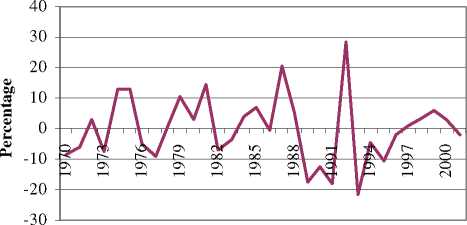K. Ludi: consumption behaviour in Zambia
and the comparison of consumption behaviour to poverty levels are done in section 5. A
conclusion with policy implications in section 6 completes this paper.
2. Background of Zambian Private Consumption Expenditure
Zambia has overall shown a level trend in real private consumption expenditure (PCE)
since 1970. As can be seen from figure 1, there was slight growth in real PCE in the
1970s, which was followed by a peak in the late-1980s. A sharp decline in real PCE in
the early-1990s followed, from which the economy has not recovered.
Figure 1: Real PCE in Zambia in constant Zambian Kwatchas (millions) (1970 - 2001)

Figure 2 indicates that the increased growth in real PCE in Zambia in the late-1990s
contributed to the positive real GDP growth rates of that period. However, the alarming
trend is one of decreasing and negative growth rates in the early-2000s.
Figure 2: Annual growth rates of real PCE in Zambia (1970 - 2001)

More intriguing information
1. The name is absent2. The Effects of Reforming the Chinese Dual-Track Price System
3. Workforce or Workfare?
4. The name is absent
5. Structural Conservation Practices in U.S. Corn Production: Evidence on Environmental Stewardship by Program Participants and Non-Participants
6. Improvements in medical care and technology and reductions in traffic-related fatalities in Great Britain
7. The name is absent
8. Bidding for Envy-Freeness: A Procedural Approach to n-Player Fair Division Problems
9. The name is absent
10. The bank lending channel of monetary policy: identification and estimation using Portuguese micro bank data